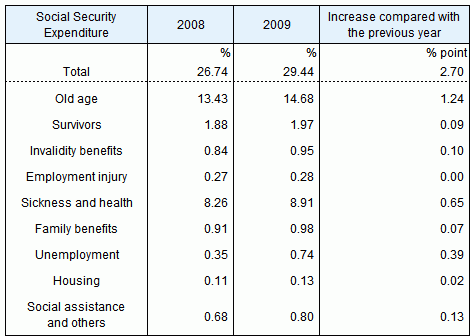|
1.
|
Social Security Expenditure in fiscal year 2009 was 99,850.7 billion yen.
|
|
 |
 |
 |
| ( i ) |
|
Of the three categories, Medical care was estimated at 30,844.7 billion yen, accounting for 30.9 percent of the total; Pensions was 51,724.6 billion yen for a total share of 51.8 percent. Welfare & Others was 17,281.4billion yen for a total share of 17.3 percent.
|
| ( ii ) |
|
Social Security Expenditure increased by 6.1 percent in fiscal year 2009. The percentage share of the National Income was 29.44 percent.
|
| ( iii ) |
|
Social Security Expenditure per head of population was estimated at 783,100 yen, and the average expenditure per household was 2,052,200 yen.
|
Table 1 Social Security Expenditure
by category, fiscal years 2008 and 2009

Note: ( ) The ratio to the total is expressed as a percentage.
Table 2 Social Security Expenditure
by category as a percentage of National Income

Table 3 Social Security Expenditure
per head of population and per household, fiscal years 2008 and 2009

Note: |
Social Security Expenditure per household
= (Total number of people in households/Total number of
households) × Social Security Expenditure per head
of population.
|
Figure 1 Social Security Expenditure
by category, fiscal years 1970-2009

|
|
2.
|
As can be seen in Table 4 below showing Social Security Expenditure by functional category, “Old age” heads the list with 49.9% of the total, followed by “Sickness and health” at 30.3%. These two functional categories make up approximately 80.2% of the entire Social Security Expenditure. The other functional categories and their percentages of the total are “Survivors” (6.7%), “Family benefits” (3.3%), “Invalidity benefits” (3.2%), “Social assistance and others” (2.7%), “Unemployment” (2.5%), “Employment injury” (0.9%) and “Housing” (0.4%).
|
Table 4 Social Security Expenditure by functional
category, fiscal years 2008 and 2009

|
Notes:
|
1.
|
( ) The ratio to the total is expressed
as a percentage.
|
|
|
2.
|
Refer to ‘Reference’ for more details about functional classifications. |
Table 5 Social Security Expenditure by functional
category as a percentage of National Income

Figure 2 Social Security Expenditure by
functional category, fiscal years 2005-2009

|
3.
|
Social Security Expenditure for the elderly (i.e., retirement pensions, medical care for the aged, welfare services for the aged) was 68,642.2 billion yen. Its share of Social Security Expenditure was 68.7 percent.
|
Table 6 Social Security Expenditure for
the elderly, fiscal years 2008 and 2009

|
Notes:
|
1.
|
( ) The ratio to the total Social Security Expenditure
is expressed as a percentage.
|
|
|
2.
|
Following the enforcement of the new medical care system for latter-stage elderly in April 2008, the medical care expenditure in fiscal year 2008 consists of medical care benefits paid under both the new system after April 2008 and the past system until March 2008.
|
|
|
3.
|
Health and medical services expenditure for the aged consists of expenditures concerning measures for care control, the welfare service expense not covered by long-term care insurance, etc.
|
| |
4.
|
Elderly employment maintenance benefits provide
those over 60 who, from the time of reaching 60 years of age,
are to continue working with a pay cut of more than 25%,
with the equivalent of 15% of their pay until they reach 65 years of age,
with the aim of promoting the maintenance of employment and reemployment
among people aged between 60 and 65.
|
Return to the Contents
Return to the top page of The Cost of Social Security in Japan

|